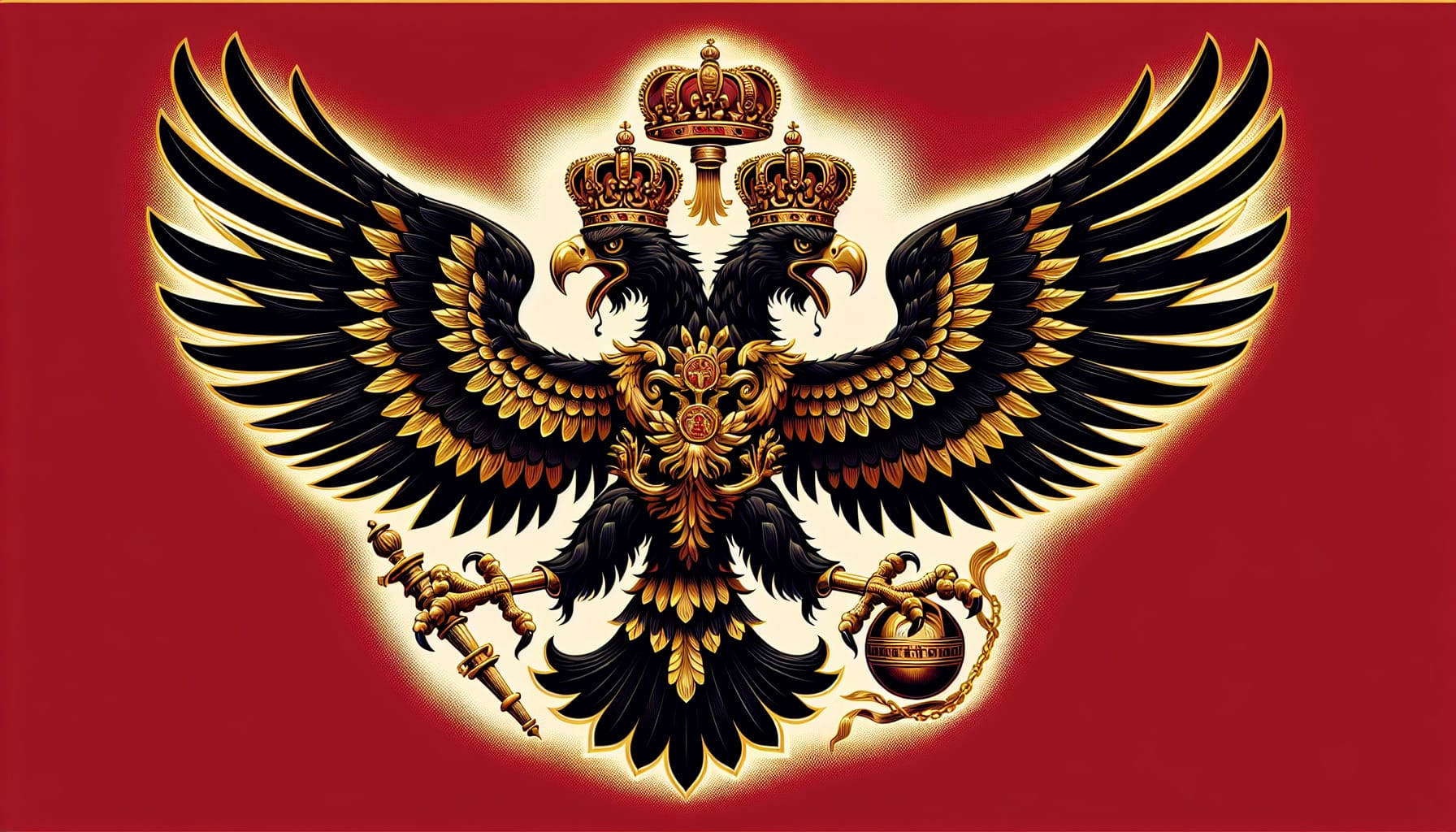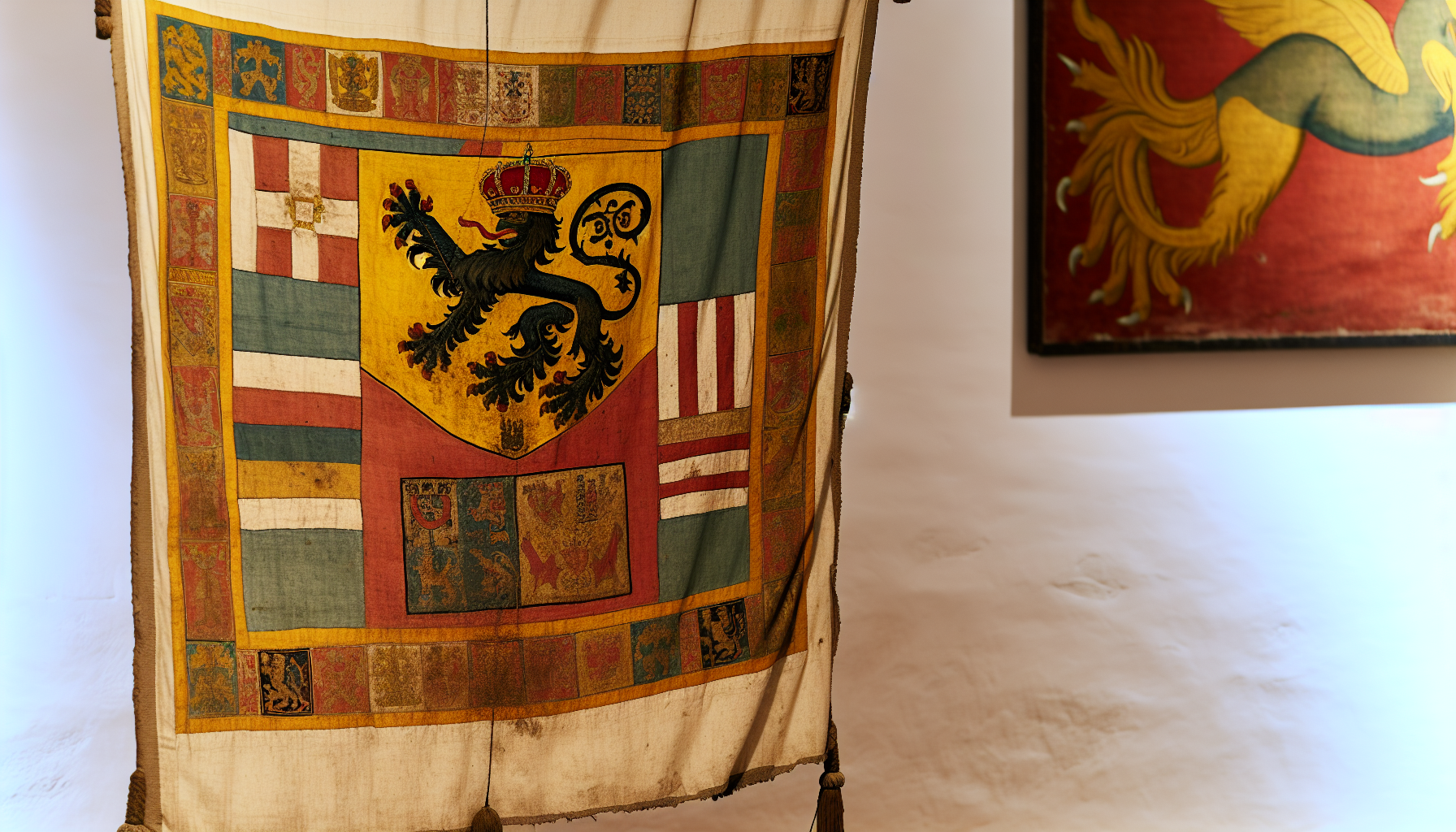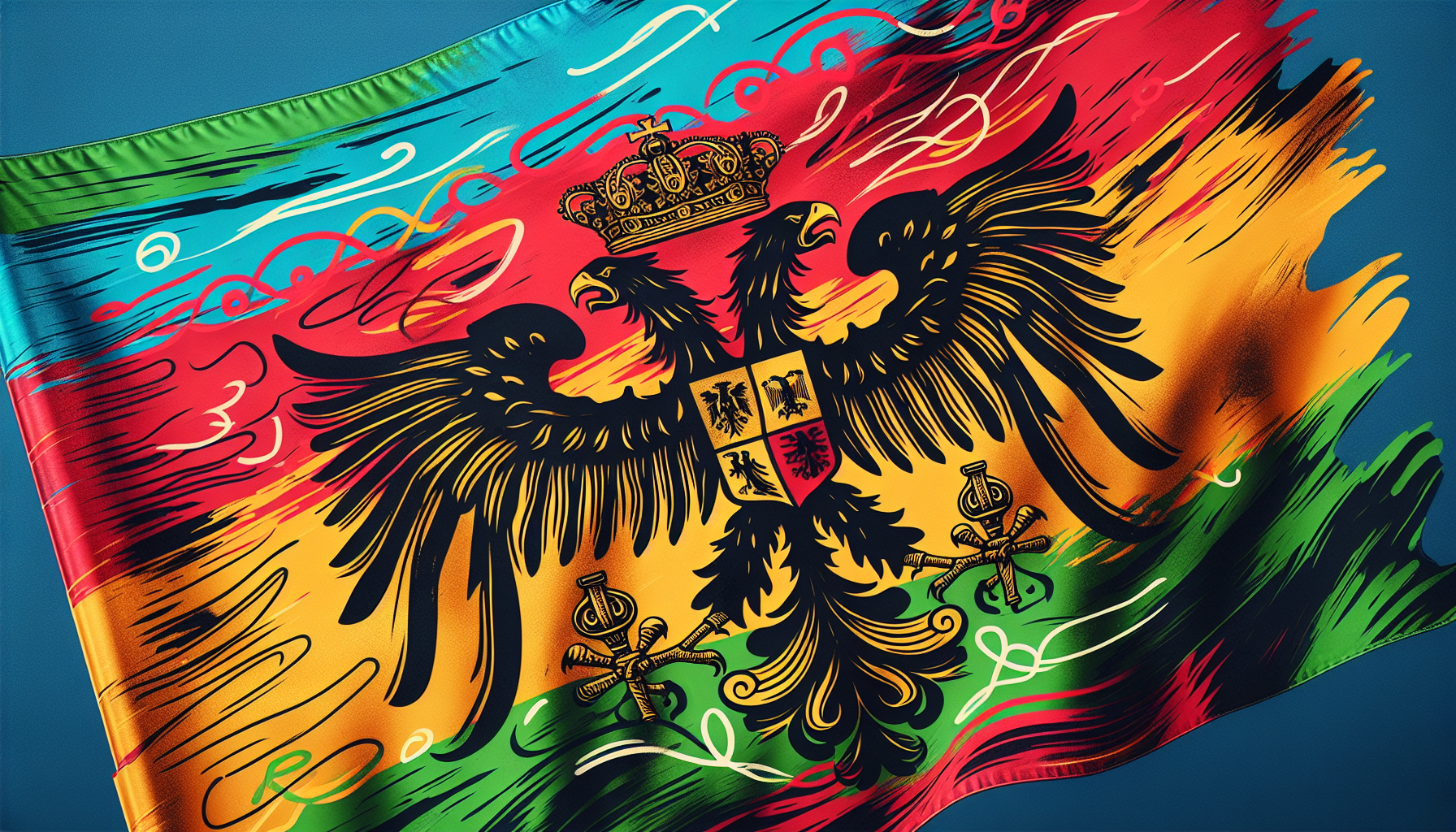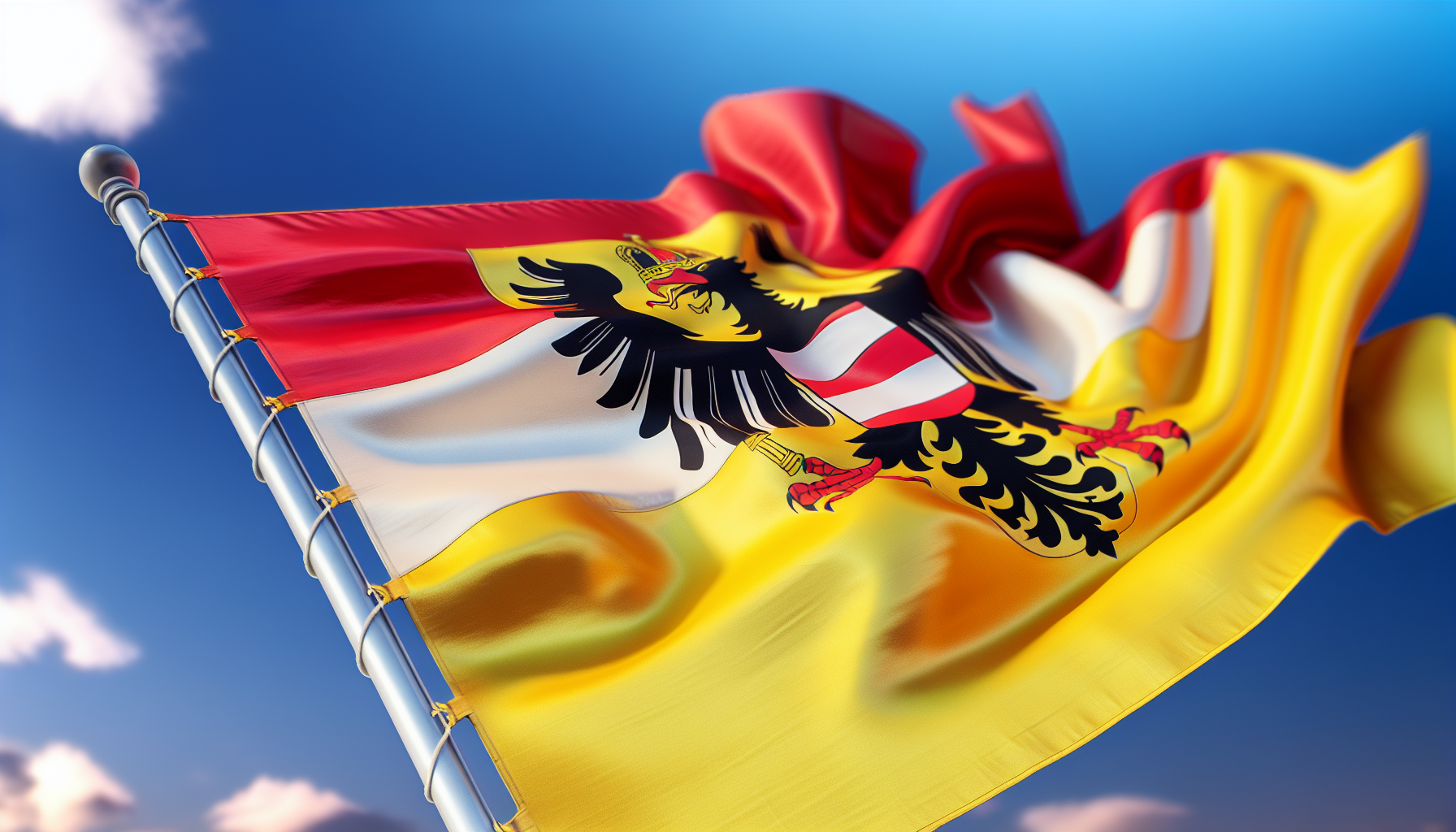The ‘Roman Empire flag’ invokes images of eagles and ancient insignias, yet Rome’s vast legacy surpassed a single flag. This guide cuts through history to reveal the varied military standards that bespoke Roman authority and left an indelible mark on successor flags. Embark on a journey from the legionnaire’s eagle to the heraldry of empires that followed.
Key Takeaways
- The Roman Empire had no single flag but used various battle standards and inscriptions, with symbols like the SPQR and the Imperial Eagle to represent its authority and military.
- Throughout the Holy Roman Empire, the Imperial Eagle evolved into a central symbol on flags, with variations including the Emperor’s Banners with a double-headed eagle, Territorial Flags showing loyalty, and flags of Imperial Cities reflecting their status.
- The influence of Roman and Holy Roman Empire flags persists in modern times, with the legacy seen in the national flags of countries like Germany and Austria, and in the symbolic use of colors and the eagle.
Evolution of the Roman Empire Flag

Rome, an empire defined by its vast influence and grandeur, lacked a national flag as we know it today. Instead, their military might was symbolized by flags, or Signum and Vexillum as they were known, each carrying a unique blend of symbolism and functionality.
In lieu of a flag, battle standards and public inscriptions served as emblems of Roman collective identity, prominently featuring the letters S.P.Q.R to represent the senate and the people. Among these symbols, the halo sable armed design was occasionally used to signify strength and unity.
Early Military Standards
Roman military insignia transcended the role of mere markers. They were symbols of pride and significance, serving as communication tools on the battlefield. They were held aloft by Signifers, embodying the essence of each legion. Some, like the Imago, bore the image of the reigning emperor, underscoring his presence within the army.
The eagle or Aquila, standing as a representation of the god Jupiter, emerged as the most recognized symbol among these standards. Made from bronze or silver, it became the emblem of the Roman Legion during the time of Gaius Marius. The Vexillum, a flag-like standard, and the Draco, a dragon-shaped standard, were also used by various sections of the army. The Labarum, Emperor Constantine I’s personal ensign, eventually became a common standard with a distinctive design.
Transition to Imperial Eagle
Following the Roman defeat at the Battle of Arausio, Gaius Marius instituted the Imperial Eagle as the chief military standard for the Roman Empire flag. This eagle, often referred to as the black eagle, not only symbolized the god Jupiter but also the expansive reach and dominion of Rome across the world, often depicted as an eagle hovering over a globe. The loss of the eagle standard in battle was a severe dishonor for a Roman legion, often leading to its disbanding until the standard was reclaimed.
Holy Roman Empire Flags

As the socio-political landscape shifted over time, so too did the banners of Rome and the Roman Empire flag, evolving to mirror these changes. The Holy Roman Empire, a multi-ethnic complex of territories in Western and Central Europe, saw the Imperial Eagle becoming a central symbol on its flags. The Emperor’s Banners, the Territorial Flags, and the Flags of Imperial Cities each bore unique variations of this symbol, reflecting a shared heritage yet maintaining their distinct identities.
Emperor’s Banners
Rich in symbolism, the Emperor’s banners featured distinct designs. Some key features of the banners include:
- The single-headed eagle was replaced by a double-headed one around the early 15th century, signifying the expanding influence and prestige of the empire.
- The eagle was often depicted with a halo, a sacrosanct symbol of the empire’s authority.
- The traditional colors were black and gold, a design that would later influence the Austrian Empire’s flag.
Emperor Frederick III added his coat of arms to the Imperial Banner in 1437, and in 1438, the banner included images of the imperial regalia. These designs changed with the lineage, as seen when the arms of Maximilian I on the Imperial Banner were replaced by those of Charles V in 1519. The eagle on the Imperial Banner was often portrayed with a red beak and claws, symbolizing imperial power, and was shown holding the orb and scepter.
Territorial Flags

Territorial Flags within the Holy Roman Empire were, unlike the Roman Empire flag, imbued with significant symbolism, encapsulating the power, heritage, and fealty of local rulers to the Emperor. The Reichsfahne, a war banner representing the united armed forces of the Holy Roman Empire, evolved into the Reichssturmfahne featuring the Imperial Eagle.
These flags were not just symbols of loyalty but also declared political stances. In the Guelphs and Ghibellines conflict, territories showcased their political stance through their flags. Territories like Geneva and the Duchy of Burgundy combined local symbols with elements showcasing their association with the Empire, including the Imperial Eagle.
Flags of Imperial Cities
Echoing the Emperor’s Banners and Territorial Flags, the Flags of Imperial Cities also prominently showcased the Imperial Eagle. They symbolized their direct subordination to the Emperor and showcased their valued status of Imperial immediacy. These flags are still reproduced today for historical enthusiasts and serve as a testament to their historical status within the Holy Roman Empire.
Examples of detailed flag designs include the flag of the Free Imperial City of Memmingen, featuring a half Imperial Eagle and a half cross pattée, and the flag of Nuremberg, which combines a double-headed Imperial Eagle with a bendy of red and white.
The Last Holy Roman Emperor: Francis II
Any narrative of the Holy Roman Empire flags remains incomplete without acknowledging Francis II, the Empire’s last Emperor, and his predecessor, Francis I. Ascending to the throne on 5 July 1792, following the death of his father, Leopold II, Francis II faced significant territorial losses to France, which diminished the Holy Roman Empire’s influence and power in Europe. His reign was marked by challenges and the decline of the Holy Roman Empire.
Reign and Dissolution of the Empire
The fierce change marked the reign of Francis II. With Napoleon’s military success and the widespread influence of social and political reforms brought by the French military, the Holy Roman Empire was facing significant challenges. The Austrian defeat in the War of the Second Coalition led to the cession of the left bank of the Rhine to France.
The Battle of Austerlitz in 1805 marked a significant defeat for Austria, which contributed to the decline of the Holy Roman Empire. Further losses and the rise of the Confederation of the Rhine led to the abdication of Francis II in 1806, effectively dissolving the Holy Roman Empire.
Following the dissolution, Francis II adopted the title of Emperor of Austria, making only minor modifications to the Holy Roman Empire’s imperial symbols and Roman Empire flag for the Austrian Empire.
Flag of Francis II

Representing the sovereignty of the Holy Roman Emperor, the flag of Francis II featured:
- The double-headed Imperial Eagle
- The eagle displayed with a halo
- The eagle armed and langued in red
- A gold field
This flag underscored the Empire’s dominion and authority over both Western and Eastern lands. Notably distinct from the war flag, this flag symbolized the reign of the last Holy Roman Emperor.
Influence of the Roman Empire Flag on Modern Flags
Modern flag designs bear a profound imprint from the Roman Empire flags. As we trace the threads of history, we can see the remnants of the Holy Roman Empire flags in the national flags of Germany and Austria. The enduring legacy of these flags is a testament to the far-reaching influence of the Roman Empire.
Austrian Empire Flag

In 1804, when Emperor Francis II declared his personal domain to be the Austrian Empire, the flag of the new empire incorporated the black and gold colors of the Holy Roman Empire flag. These colors reflected the Habsburgs’ colors, revealing the impact of the Holy Roman Empire’s imperial culture on the Austrian monarchy.
The black-yellow flag was retained as the national flag of the Austrian Habsburg monarchy and the Austrian Empire until the end of World War I in 1918.
German Imperial Banner
The German Imperial Banner, influenced by the Roman Empire flag, adopted the Imperial Eagle as a unified symbol of imperial power. This marked a shift from the cross motif, which had been prominent during the Crusades. The use of imperial banners, including the German Imperial Banner, showcased the influence of the Roman Empire on the design and symbolism of these flags.
The black-red-gold tricolor, associated with the Holy Roman Empire, became symbolic of the German liberal, democratic, and republican movement. Post the dissolution of the Holy Roman Empire, the German Confederation didn’t establish an official flag, allowing the tricolor to become an emblem of political ideals within the German states.
Summary
In conclusion, the flags of the Roman Empire, from their military origins to the intricate designs of the Holy Roman Empire flag, have woven a rich tapestry of symbolism and heritage. The ebb and flow of their designs reflected the socio-political tides of the time, from the reign of the early Roman military to the last Holy Roman Emperor, Francis II. The legacy of these flags endures in the national banners of modern nations, a testament to the enduring influence of the Roman Empire.
Frequently Asked Questions
Did the Roman Empire have a flag?
No, the Roman Empire did not have a national flag. Rather, flags were commonly associated with military units, and soldiers had a strong personal attachment to the insignia with a golden eagle on top.
What does the Roman Empire flag represent?
The predominant banner during the Republican era was the SPQR banner, which stands for Senatus Populusque Romanus. The symbol that represented Roman civilization was the eagle. Each legion carried an eagle, and it was seen as a symbol of Jupiter.
What was the concept of the Holy Roman Empire flag?
The Holy Roman Empire flag was not a national flag but rather an imperial banner used by the Holy Roman Emperor. Black and gold were used as the colors of the imperial banner, a black eagle on a golden background. After the late 13th or early 14th century, the claws and beaks of the eagle were colored red.
What does the SPQR stand for?
SPQR stands for Senatus Populusque Romanus, which translates to “The Senate and People of Rome.” It was used as a reference to the entirety of the Roman state, encompassing its Senate and its people.
What was the Roman standard flag?
The Roman standard flag was the vexillum, which resembled the modern flag and showed what legion the soldiers belonged to.
What was the Roman Empire flag called?
The vexillum was a flag-like object used as a military standard by units in the Roman army. A common vexillum displayed imagery of the Roman Aquila on a reddish backdrop.
What is the significance of the Imperial Eagle?
The Imperial Eagle was the primary military standard of the Roman army, symbolizing the extensive reach and dominion of Rome across the world, showcasing its military power and authority.
Who was the last Holy Roman Emperor?
The last Holy Roman Emperor was Francis II, whose reign led to the dissolution of the Holy Roman Empire in 1806.
Hello, my name is Vladimir, and I am a part of the Roman-empire writing team.
I am a historian, and history is an integral part of my life.
To be honest, while I was in school, I didn’t like history so how did I end up studying it? Well, for that, I have to thank history-based strategy PC games. Thank you so much, Europa Universalis IV, and thank you, Medieval Total War.
Since games made me fall in love with history, I completed bachelor studies at Filozofski Fakultet Niš, a part of the University of Niš. My bachelor’s thesis was about Julis Caesar. Soon, I completed my master’s studies at the same university.
For years now, I have been working as a teacher in a local elementary school, but my passion for writing isn’t fulfilled, so I decided to pursue that ambition online. There were a few gigs, but most of them were not history-related.
Then I stumbled upon roman-empire.com, and now I am a part of something bigger. No, I am not a part of the ancient Roman Empire but of a creative writing team where I have the freedom to write about whatever I want. Yes, even about Star Wars. Stay tuned for that.
Anyway, I am better at writing about Rome than writing about me. But if you would like to contact me for any reason, you can do it at contact@roman-empire.net. Except for negative reviews, of course. 😀
Kind regards,
Vladimir
